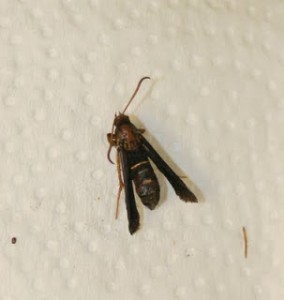Do It Yourself – Grape Root Borer Monitoring (March 2014)
go.ncsu.edu/readext?284856
en Español / em Português
El inglés es el idioma de control de esta página. En la medida en que haya algún conflicto entre la traducción al inglés y la traducción, el inglés prevalece.
Al hacer clic en el enlace de traducción se activa un servicio de traducción gratuito para convertir la página al español. Al igual que con cualquier traducción por Internet, la conversión no es sensible al contexto y puede que no traduzca el texto en su significado original. NC State Extension no garantiza la exactitud del texto traducido. Por favor, tenga en cuenta que algunas aplicaciones y/o servicios pueden no funcionar como se espera cuando se traducen.
Português
Inglês é o idioma de controle desta página. Na medida que haja algum conflito entre o texto original em Inglês e a tradução, o Inglês prevalece.
Ao clicar no link de tradução, um serviço gratuito de tradução será ativado para converter a página para o Português. Como em qualquer tradução pela internet, a conversão não é sensivel ao contexto e pode não ocorrer a tradução para o significado orginal. O serviço de Extensão da Carolina do Norte (NC State Extension) não garante a exatidão do texto traduzido. Por favor, observe que algumas funções ou serviços podem não funcionar como esperado após a tradução.
English
English is the controlling language of this page. To the extent there is any conflict between the English text and the translation, English controls.
Clicking on the translation link activates a free translation service to convert the page to Spanish. As with any Internet translation, the conversion is not context-sensitive and may not translate the text to its original meaning. NC State Extension does not guarantee the accuracy of the translated text. Please note that some applications and/or services may not function as expected when translated.
Collapse ▲This afternoon, I’m heading to Duplin County to visit a group of muscadine grape growers and to talk about grape root borer. A few years ago, I posted a step by step to grape root borer monitoring, and in preparation for today’s meeting, I am sharing that information here.
Grape root borer (Vitacea polistiformis (Harris)) is potentially the most significant pest of grapes (both muscadine and Vinfera) in the southeast. Larvae have a 1 to 2 year life cycle, which means that injury, in the form of weakened and dying vines, often does not present for several years. Many of the Vinfera vineyards in the Carolinas and Georgia are reaching the 8 to 10 year mark, the time at which I anticipate grape root borer injury to become more apparent.
Based on observations observations over three years from our grape root borer volunteer monitoring network (GRB*VMN), adult moth activity likely does not begin in North Carolina until early July, so traps should be placed around July 1st in order catch the earliest moth activity. I encourage growers to use either four traps per vineyard, evenly spaced, or one trap per variety block, whichever is greater.

Grape root borer trap components. From left to right: hanger, trap top, trap lid, pheromone container (front), pheromone impregnated septa (packet, front), pesticide kill strip (red, front), and trap bottom (back). Photo: Hannah Burrack
The traps I use are available from Great Lakes IPM* and pheromone lures can be purchased from Arbico-Organics* (*Does not imply endorsement of named vendors over other options.)
Traps should be assembled as follows:
Pesticide strips are used to kill moths once they enter traps. No pesticide is present outside the traps, and therefore, these traps can be used in organic systems. Pesticide strips should only be handled with protective (preferable nitrile) gloves.
Trap tops snap onto to trap bottoms.
Trap lids keep rain and other debris out of the bottoms.
Grape root borer pheromones (most attractive to male moths) are impregnated onto rubber septa and remain attractive for an entire field season.
Pheromone lures are placed into lidded containers.
The pheromone container is inserted in the trap lid and hangs into the trap opening. Moths are attracted to pheromone lures and fall into the trap bottom where they are killed by the pesticide strip. Hangers are attached to trap lids, and traps are hung from canes or trellis wires.
Traps are checked weekly, and all moths should be removed and counted. Pheromone lures are attractive at a long distance to male moths, and attractive at a short distance to females, so both sexes may be present in traps. Grape root borer moths resemble wasps but differ in that their wings are black and they lack the thin “waist” of wasps. After a few days in the traps, moths may appear darker brown.
While the grape root borer pheromone is relatively specific, it will attract one related species, the squash vine borer. However, these moths are bright orange and black and easily distinguished from grape root borer. Other insects found in traps may include beetles and small brown moths, but these should also be readily distinguishable from grape root borer moths.
Weekly moth captures should be used to determine both presence of grape root borer in your vineyard–we do not necessarily capture them in all grape plantings in North Carolina–and to determine peak activity periods, which will be used to time management activities. Refer to the NC Agricultural Chemicals Manual for management strategies for grape root borer in North Carolina and the Southern Region Small Fruit Consortium muscadine and bunch grape IPM guides for regional recommendations.
More information
Grape root borer posts – NC Small Fruit & Specialty Crop IPM
NC Agricultural Chemicals Manual
Muscadine IPM Guide – Southern Region Small Fruit Consortium
Bunch Grape IPM Guide – Southern Region Small Fruit Consortium











